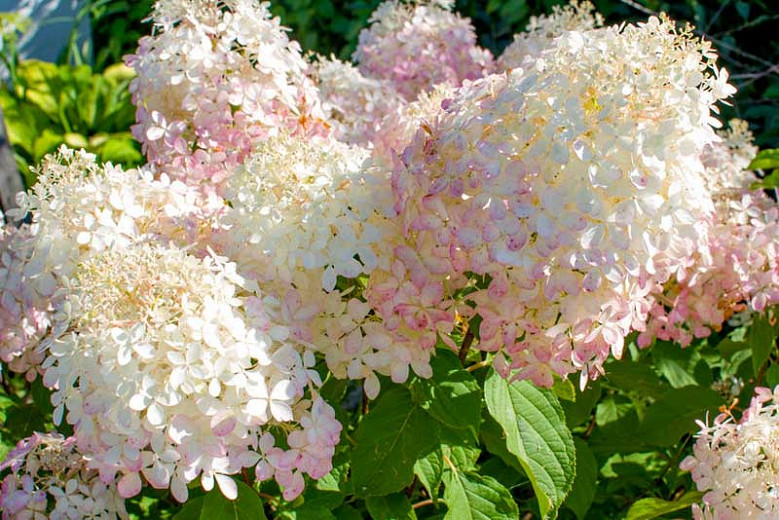The Phantom Of The Garden: How To Care For Hydrangea Paniculata 'phantom'
The Phantom of the Garden: How to Care for Hydrangea Paniculata 'Phantom'
Hydrangea paniculata 'Phantom' is a beautiful and versatile shrub that is known for its large, white flower panicles. It is a relatively easy plant to care for, but there are a few things you need to know in order to keep it healthy and thriving.
Growing Conditions
Hydrangea paniculata 'Phantom' prefers full sun to partial shade. It can tolerate some direct sunlight, but too much sun can scorch the leaves. The plant also prefers moist, well-drained soil. If the soil is too dry, the leaves will wilt and the flowers may not bloom as well.
Pruning
Hydrangea paniculata 'Phantom' should be pruned in late winter or early spring. The goal of pruning is to remove dead, diseased, or damaged branches. You should also prune back any branches that are crossing or rubbing against each other. This will help to improve the airflow around the plant and prevent disease.
Fertilizing
Hydrangea paniculata 'Phantom' should be fertilized in the spring and fall. A balanced fertilizer, such as 10-10-10, is a good choice. You can also use a fertilizer specifically formulated for hydrangeas.
Watering
Hydrangea paniculata 'Phantom' needs to be watered regularly, especially during the summer months. The soil should be kept moist, but not soggy. If the plant is not getting enough water, the leaves will wilt.
Winter Protection
In colder climates, Hydrangea paniculata 'Phantom' may need some winter protection. The plant can be damaged by temperatures below -20 degrees Fahrenheit. If you live in a cold climate, you can protect the plant by covering it with a burlap sack or a layer of mulch.
Problems
Hydrangea paniculata 'Phantom' is generally a healthy plant, but it is susceptible to a few problems. One common problem is leaf spot. Leaf spot is a fungal disease that causes brown spots on the leaves. You can treat leaf spot with a fungicide.
Another problem that Hydrangea paniculata 'Phantom' can be susceptible to is aphids. Aphids are small, sucking insects that can damage the leaves and flowers of the plant. You can treat aphids with an insecticidal soap or neem oil.
Troubleshooting
If your Hydrangea paniculata 'Phantom' is not blooming, there are a few things you can check. First, make sure that the plant is getting enough sunlight. If the plant is not getting enough sun, it will not bloom as well. Second, make sure that the plant is getting enough water. If the plant is not getting enough water, the leaves will wilt and the flowers may not bloom. Finally, make sure that the plant is fertilized properly. If the plant is not fertilized, it may not have the nutrients it needs to bloom.
Conclusion
Hydrangea paniculata 'Phantom' is a beautiful and easy-to-care-for shrub that can add a touch of elegance to any garden. By following these simple care tips, you can ensure that your plant will thrive for years to come.
Phantom Hydrangea
The phantom hydrangea (Hydrangea paniculata 'Phantom') is a stunning shrub that is sure to add a touch of elegance to any garden. With its large, white flowerheads that can measure up to 15 inches in diameter, the phantom hydrangea is a sight to behold. The flowers are borne in late summer and early fall, and they can last for several weeks.
The phantom hydrangea is a relatively easy plant to care for. It prefers full sun, but it can also tolerate partial shade. The soil should be well-drained, and the plant should be watered regularly. The phantom hydrangea is hardy in USDA zones 4-8.
If you are looking for a beautiful and unique shrub to add to your garden, the phantom hydrangea is a great choice. For more information about this plant, please visit .
FAQ of hortensia paniculata phantom
Q: What is Hortensia paniculata Phantom?
A: Hortensia paniculata Phantom is a type of hydrangea that is known for its white flowers. It is a deciduous shrub that can grow up to 6 feet tall. The flowers bloom in the summer and fall.
Q: What are the care requirements for Hortensia paniculata Phantom?
A: Hortensia paniculata Phantom is a relatively easy-care plant. It prefers full sun to partial shade, and moist, well-drained soil. It is tolerant of heat and humidity, and can be grown in USDA hardiness zones 3-8.
Q: How do I prune Hortensia paniculata Phantom?
A: Hortensia paniculata Phantom can be pruned in late winter or early spring. The best time to prune is before the plant starts to grow new leaves. To prune, simply cut back the stems by about one-third. This will encourage new growth and more flowers.
Q: What are the common pests and diseases of Hortensia paniculata Phantom?
A: Hortensia paniculata Phantom is susceptible to a few pests and diseases, including aphids, scale, and powdery mildew. Aphids can be controlled with insecticidal soap or neem oil. Scale can be controlled with horticultural oil. Powdery mildew can be controlled with a fungicide.
Q: What are the different colors of Hortensia paniculata Phantom?
A: The flowers of Hortensia paniculata Phantom can start out white, but they will gradually turn pink as they age. In the fall, the flowers may turn a darker pink or even red.
Image of hortensia paniculata phantom
5 different images of "hortensia paniculata phantom" from Pinterest:
- A white hydrangea bush with large, conical flower heads.

- A close-up of the flowers, showing their pure white color.

- A hydrangea bush in full bloom, with the flowers starting to turn pink.

- A single flower, showing its delicate petals and pink stamens.

- A landscaped garden with a hydrangea bush in the foreground.

Post a Comment for "The Phantom Of The Garden: How To Care For Hydrangea Paniculata 'phantom'"